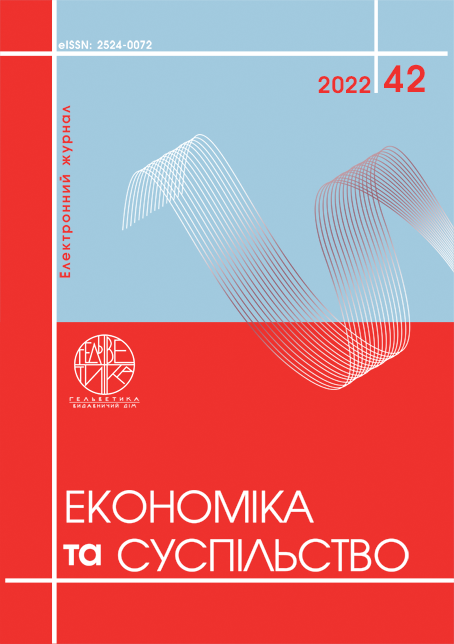STATE REGULATION OF THE INNOVATION MARKET IN UKRAINE AS A TOOL FOR STIMULATING THE INNOVATIVE ACTIVITIES OF ENTERPRISES
Abstract
It is argued, that regulation is one of the activities, that governments can engage in and can have a profound impact on the level and direction of innovation both in specific sectors and in the economy as a whole. It was determined, that the most typical prerequisite for regulation, which becomes its main goal, is the existence of situations in which market forces alone do not lead to a socially optimal result. It has been proven that long-term political goals, such as the need to develop a certain domestic market or to achieve the goals of the strategic development of the state in general, are the reason for state regulation of innovations. The chronology of state regulation of the innovation market, which is optimal for application, is substantiated. The main types of regulatory intervention in innovative activities of enterprises are singled out. The ways in which regulation can respond to market failures and other political problems are identified. It has been argued that the interaction between regulation and innovation is complex, multifaceted and often ambiguous, so that assessing the impact of a particular piece of regulation on innovation is often an empirical matter on a case-by-case basis. Regulation can be a powerful driver of innovation and entrepreneurship under certain circumstances, but sometimes regulation can and does hinder innovation. The ultimate impact of regulation on innovation is an empirical, case-by-case matter, and depends on the balance between the factors that stimulate innovation and the compliance costs caused by regulation. Different types of regulation can be identified in terms of their impact on innovation. We suggest distinguishing between general rules, rules related to innovation, and laws specific to specific industries. Different types of regulatory approach can have different effects on innovation. Generally, tighter regulation can hinder innovation by reducing the attractiveness of participation in research, limiting avenues for commercialization, and creating a lock-in effect that forces the economy to suboptimal standards. It is argued that the current review of the fundamental principles will be a valuable opportunity to strengthen the analysis of the balance between the innovation-enhancing and innovation-restricting effects of the various policy alternatives carefully considered in each impact assessment.
References
Granieri, M., Renda A. (2012). Innovation Law and Policy in the European Union, Milan: Springer.
Ardagna S., Lusardi A. (2008). “Explaining International Differences in Entrepreneurship: The Role of Individual Characteristics and Regulatory Constraints”, NBER Working Paper No. 14012, National Bureau of Economic Research, Cambridge, MA.
Bayoumi, T., Laxton D., Pesenti P. (2004). “Benefits and Spillovers of Greater Competition in Europe: A Macroeconomic Assessment”, NBER Working Paper No. 10416, National Bureau of Economic Research, Cambridge, MA.
Ehrlich, E., Eisenach J., Leighton W. (2010). “The Impact of Regulation on Innovation and Choice in Wireless Communications”, Review of Network Economics, Vol. 9, No. 1.
Fristch, O., Radaelli C., Schrefler L., Renda A. (2013), “Comparing the Content of Regulatory Impact Assessments in the UK and the EU”, Public Money and Management, Vol. 33, No. 6, pp. 445–452.
Манаєнко І. М., Кравець А. І. Фінансування інноваційної діяльності підприємств: українські реалії та досвід ЄС. Економіка та управління підприємствами. 2018. № 5. С. 109–115.
Лукашина М. В. Стратегічні напрями розвитку інноваційного підприємництва. Економіка і прогнозування. 2009. № 3. С. 86–98.
Костецький В., Примаченко І. Сучасні аспекти пошуку стимулів до інноваційної діяльності суб'єктів господарювання. Світ фінансів. 2020. № 2. C. 134–144.
Granieri, M., Renda A. (2012). Innovation Law and Policy in the European Union, Milan: Springer.
Ardagna S., Lusardi A. (2008). “Explaining International Differences in Entrepreneurship: The Role of Individual Characteristics and Regulatory Constraints”, NBER Working Paper No. 14012, National Bureau of Economic Research, Cambridge, MA.
Bayoumi, T., Laxton D., Pesenti P. (2004). “Benefits and Spillovers of Greater Competition in Europe: A Macroeconomic Assessment”, NBER Working Paper No. 10416, National Bureau of Economic Research, Cambridge, MA.
Ehrlich, E., Eisenach J., Leighton W. (2010). “The Impact of Regulation on Innovation and Choice in Wireless Communications”, Review of Network Economics, Vol. 9, No. 1.
Fristch, O., Radaelli C., Schrefler L., Renda A. (2013), “Comparing the Content of Regulatory Impact Assessments in the UK and the EU”, Public Money and Management, Vol. 33, No. 6, pp. 445–452.
Manayenko I. M., Kravetsʹ A. I. (2018) Finansuvannya innovatsiynoyi diyalʹnosti pidpryyemstv: ukrayinsʹki realiyi ta dosvid YES [Financing innovative activities of enterprises: Ukrainian realities and EU experience]. Ekonomika ta upravlinnya pidpryyemstvamy. № 5. S. 109–115.
Lukashyna M. V. (2009) Stratehichni napryamy rozvytku innovatsiynoho pidpryyemnytstva [Strategic directions of development of innovative entrepreneurship]. Ekonomika i prohnozuvannya. № 3. S. 86–98.
Kostetsʹkyy V., Prymachenko I. (2020). Suchasni aspekty poshuku stymuliv do innovatsiynoyi diyalʹnosti sub'yektiv hospodaryuvannya [Modern aspects of the search for incentives for innovative activity of business entities]. Svit finansiv. № 2. S. 134–144.


